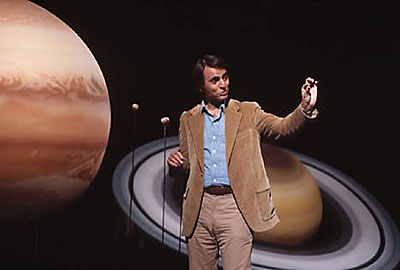Where have you gone, Joe DiMaggio?by Dwayne A. Day
|
| Wondrous things are happening way out there in the deep cold black of outer space and we do not have anybody to turn the science into poetry. |
You can see this on the television talk shows. A few astronauts and scientists have appeared on late night talk shows over the years, but they have never been asked back. The hottest late night “news” entertainment program, Jon Stewart’s The Daily Show, has also been decidedly negative about space. When the Mars rovers discovered evidence of water on Mars—as everyone knows, it is a fundamental prerequisite for life as we know it—Stewart’s response was to ask why we had spent hundreds of millions of dollars to discover something that we can get in the bathroom sink. More recently, when scientists reported the results from Cassini’s study of Saturn’s beautiful and mysterious rings, Stewart was equally dismissive: “Three billion dollars and they discovered dirt?”
The Mars rover program has Steve Squyres, the Cornell University scientist whose geeky exuberance is a welcome change from the typical droll, somewhat bureaucratic NASA principal investigator’s demeanor. But Squyres’ delivery is reminiscent of the enthusiastic high school science teacher trying to convince bored students that science really is neat, honest. His greatest appeal is to people who are already convinced.
Another person in the space community who regularly plays the spokesman role to the general public is Robert Zubrin. But Zubrin is a little, well, hard-edged. His enthusiasm translates into zealotry and he often comes across like a southern fundamentalist preacher whom the choir loves, but who scares away people at the church door. If you engage him in conversation, you get the vague feeling that he is about to go for your neck. He appears to have softened his message and his delivery somewhat over the past few years, but he still makes space enthusiasm seem somewhat off-putting to outsiders, like being at a Trekkie convention.
My money is on Neil deGrasse Tyson, the director of the Hayden Planetarium in New York City. Tyson has charisma and pedigree and the necessary sense of wonder (although you have to worry about a man who seriously considered downgrading Pluto from planetary status). He is certainly a media darling. But there’s still something missing. I don’t know what it is. If somebody can identify it, maybe we can get him to fix it.
What we need is another Carl Sagan, who doesn’t talk down to the general (ignorant) public, but also wants to bring them along for the ride through this wondrous and mysterious universe. Sagan used to appear regularly on Johnny Carson’s The Tonight Show, talking about the Voyager missions to the outer planets or the latest discoveries in astronomy as if he was telling a story about something that had happened to him last week. People made fun of his delivery at times—“billions and billions…”—but they respected him, and they understood him because he had a way of taking the extraordinary and making it seem understandable, yet still extraordinary. When he explained how the basic matter that makes up every human being was generated in the cores of exploding stars he coined a memorable shorthand explanation: “We are starstuff,” he said, and it all made sense.
| What we need is another Carl Sagan, who doesn’t talk down to the general (ignorant) public, but also wants to bring them along for the ride through this wondrous and mysterious universe. |
How do we get that back? We’re going to need it. NASA leaders think that billions of hits to the Mars rover website is great news, but that is somehow empty and unfulfilling: a statistic. The Internet is no substitute for storytelling. We need something more. We need someone who can explain why this space stuff is important so that, well… so that we can do more of it. Maybe we should send the current group of space scientists to charm school. Get them a Hollywood publicist who can train them and massage their image. It is probably easier to turn a scientist into a poet than it is to turn an actor into an astrophysicist. Maybe we can get the scientific community working on this. Can somebody genetically engineer charm and charisma and all those things that Carl Sagan had—put it in a bottle so we can feed it to a few people? Better yet, let’s just clone Sagan.
Read these words that Sagan wrote in Pale Blue Dot. Read them and weep:
“Look again at that dot. That’s here. That’s home. That’s us. On it everyone you love, everyone you know, everyone you ever heard of, every human being who ever was, lived out their lives. The aggregate of our joy and suffering, thousands of confident religions, ideologies, and economic doctrines, every hunter and forager, every hero and coward, every creator and destroyer of civilization, every king and peasant, every young couple in love, every mother and father, hopeful child, inventor and explorer, every teacher of morals, every corrupt politician, every superstar, every ‘supreme leader,’ every saint and sinner in the history of our species lived—on a mote of dust suspended in a sunbeam.”
Carl Sagan, we need you, buddy.
